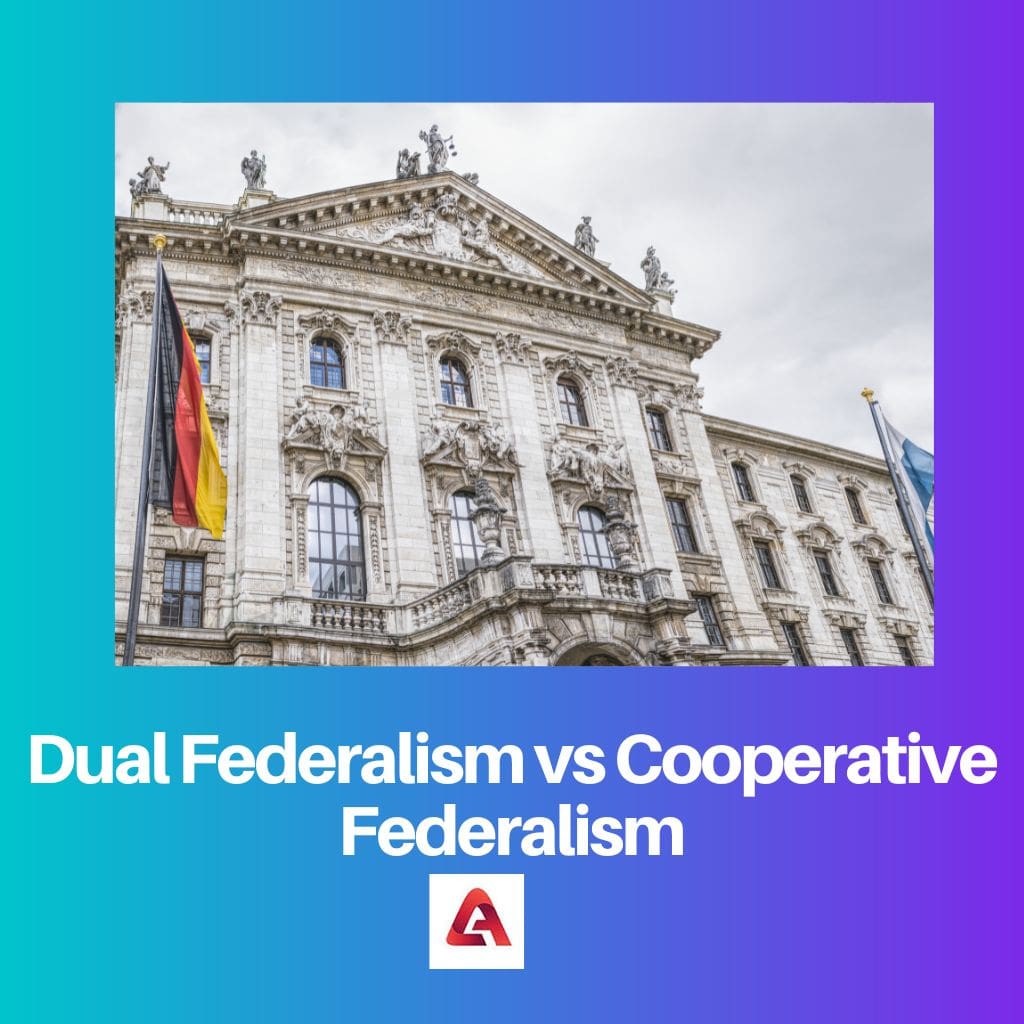Dual federalism refers to a system where powers are strictly divided between the national and state governments, each exercising authority within their own sphere without much overlap. Cooperative federalism, on the other hand, entails a more collaborative approach, where the national and state governments work together, sharing responsibilities and resources to address common issues and achieve common goals.
Key Takeaways
- Dual federalism is a system where state and federal governments operate independently in their respective spheres of influence.
- Cooperative federalism is a system where state and federal governments work together to achieve common goals.
- Dual federalism limits the federal government’s role, while cooperative federalism emphasizes intergovernmental cooperation and coordination.
Dual Federalism vs Cooperative Federalism
In dual federalism, there is a division of power between a state government and a central government, which means that both exercise their powers within their jurisdiction. In cooperative federalism, the central and state governments collaborate to make decisions and solve problems.

Comparison Table
| Feature | Dual Federalism | Cooperative Federalism |
|---|---|---|
| Power Distribution | Strict separation of powers between national and state governments | Shared and overlapping powers between national and state governments |
| Relationship between Levels | Vertical and independent: National and state governments operate in separate spheres with limited interaction. | Horizontal and collaborative: National and state governments work together to achieve common goals. |
| Key Concept | Layer Cake Model: National and state governments are seen as distinct layers with separate and well-defined responsibilities. | Marble Cake Model: National and state governments are seen as intertwined, with their powers and responsibilities blending together. |
| Historical Era | Primarily 19th and early 20th centuries | Primarily mid-20th century to present |
| Examples | Early Supreme Court decisions like McCulloch v. Maryland (1819) | Programs like Medicaid, which involves both national funding and state administration |
| Emphasis | Limited national government: Focuses on preserving state autonomy and preventing federal overreach. | Shared responsibility: Focuses on collaboration and finding solutions to complex problems that require cooperation between different levels of government. |
What is Dual Federalism?
Dual federalism, also known as “layer cake federalism,” is a political theory that emphasizes the clear and distinct division of powers and responsibilities between the national government and state governments within a federation. This concept was predominant in the early years of the United States, particularly during the 19th century, and it has had a significant impact on the country’s constitutional framework and the interpretation of federal powers.
Key Characteristics of Dual Federalism
1. Clear Separation of Powers:
- Under dual federalism, there is a strict separation of powers between the national government and state governments, with each level of government having its own sphere of authority. This separation is likened to distinct layers of a cake, where the powers of each level are clearly delineated and do not overlap.
2. Limited National Government Authority:
- In dual federalism, the powers granted to the national government are specifically enumerated in the Constitution, primarily through the “enumerated powers” outlined in Article I, Section 8. The national government is only authorized to exercise these powers, such as regulating interstate commerce, national defense, and foreign policy, while all other powers are reserved to the states or the people, as stated in the Tenth Amendment.
3. State Autonomy and Sovereignty:
- State governments retain significant autonomy and sovereignty under dual federalism. They have authority over a wide range of issues that directly affect their residents, including education, public health, transportation, and law enforcement. States operate their own governments, pass laws, and collect taxes independently of the national government.
4. Limited Interference between Levels of Government:
- Dual federalism promotes the idea of “dual sovereignty,” wherein the national and state governments operate independently within their respective spheres without significant interference from each other. This principle restricts the ability of the national government to intrude upon areas traditionally reserved to the states, and vice versa.
Historical Context and Legacy
1. Founding Era and Early Development:
- Dual federalism reflects the vision of the Founding Fathers, who sought to establish a federal system that balanced national unity with state autonomy. The Tenth Amendment, ratified in 1791 as part of the Bill of Rights, explicitly codified the principle of federalism by reserving powers to the states not delegated to the national government.
2. Supreme Court Interpretations:
- Throughout the 19th century, the Supreme Court played a crucial role in defining the scope of federal powers and reinforcing the principles of dual federalism. Decisions such as McCulloch v. Maryland (1819) and Gibbons v. Ogden (1824) affirmed the supremacy of federal law in areas of national concern while upholding states’ rights in local matters.
3. Evolution and Decline:
- The concept of dual federalism began to erode during the late 19th and early 20th centuries, particularly with the rise of progressive reforms and the expansion of federal authority in response to national challenges such as the Great Depression and World War II. The New Deal era marked a significant shift towards cooperative federalism, as the national government became more involved in regulating the economy and providing social welfare programs.

What is Cooperative Federalism?
Cooperative federalism, referred to as “marble cake federalism,” is a concept in political theory that emphasizes collaboration and shared governance between the national government and state governments within a federal system. Unlike the clear separation of powers seen in dual federalism, cooperative federalism promotes intergovernmental cooperation and joint decision-making to address complex issues and achieve common goals.
Key Characteristics of Cooperative Federalism
1. Shared Responsibilities and Authority:
- In cooperative federalism, both the national government and state governments share responsibilities and authority in addressing various policy areas. Rather than operating within distinct spheres, they work together to develop and implement policies, with each level of government contributing its resources and expertise.
2. Flexible Division of Powers:
- Unlike the rigid division of powers in dual federalism, cooperative federalism allows for a more flexible arrangement where the allocation of powers between the national and state governments can vary depending on the issue at hand. This flexibility enables governments to adapt to changing circumstances and collaborate more effectively.
3. Interconnected Policy Implementation:
- Policies and programs in cooperative federalism involve joint efforts and coordination between multiple levels of government. This interconnected approach ensures that decisions are informed by diverse perspectives and that resources are effectively utilized to achieve desired outcomes.
4. Intergovernmental Grants and Partnerships:
- Cooperative federalism is facilitated through intergovernmental grants and partnerships, where the national government provides funding and support to state governments for specific initiatives. These grants may come with conditions or requirements to ensure alignment with national priorities, but they also offer states flexibility in tailoring programs to local needs.
Historical Context and Evolution
1. New Deal and Expansion of Federal Authority:
- The emergence of cooperative federalism can be traced back to the New Deal era of the 1930s, when the national government expanded its role in addressing the economic challenges of the Great Depression. Programs such as Social Security, the Works Progress Administration, and the Tennessee Valley Authority involved collaboration between the federal government and state governments to implement large-scale initiatives.
2. Evolution through Intergovernmental Relations:
- In the post-World War II period, cooperative federalism continued to evolve through the establishment of formal mechanisms for intergovernmental cooperation, such as federal-state conferences and councils. These forums provided opportunities for governments to coordinate policies, share best practices, and resolve conflicts in areas of overlapping jurisdiction.
3. Expansion of Federal Grants-in-Aid:
- The proliferation of federal grants-in-aid, especially since the mid-20th century, has been a central feature of cooperative federalism. Programs such as Medicaid, transportation infrastructure grants, and education funding have relied on federal-state partnerships to achieve their objectives, with the national government providing financial assistance and states contributing to program implementation.
Contemporary Application and Challenges
1. Modern Policy Challenges:
- In contemporary governance, cooperative federalism continues to be relevant in addressing complex policy challenges such as healthcare, environmental protection, and homeland security. These issues require coordinated action across multiple levels of government to achieve meaningful results.
2. Tensions between Collaboration and Autonomy:
- While cooperative federalism offers advantages in terms of efficiency and effectiveness, it also raises questions about the balance between collaborative governance and state autonomy. Tensions may arise when states perceive federal interventions as encroachments on their sovereignty or when there are disagreements over policy priorities and resource allocation.
3. Role of Intergovernmental Relations:
- Intergovernmental relations mechanisms, including federalism commissions, task forces, and interstate compacts, play a crucial role in facilitating cooperative federalism and managing conflicts between different levels of government. These forums provide opportunities for dialogue, negotiation, and consensus-building to overcome barriers to collaboration.

Main Differences Between Dual Federalism and Cooperative Federalism
- Division of Powers:
- Dual Federalism: Powers are strictly divided between the national and state governments with limited overlap.
- Cooperative Federalism: Collaboration and shared governance between national and state governments are emphasized, with a more flexible division of powers.
- Autonomy and Sovereignty:
- Dual Federalism: Emphasizes state autonomy and sovereignty, with states retaining significant authority over local matters.
- Cooperative Federalism: Involves shared responsibilities and authority between national and state governments, leading to interconnected policy implementation.
- Interactions between Levels of Government:
- Dual Federalism: Advocates for limited interference between national and state governments, with each level operating independently within its sphere of authority.
- Cooperative Federalism: Encourages intergovernmental cooperation and partnerships, with policies and programs requiring joint efforts and coordination.
- Historical Context:
- Dual Federalism: Rooted in the early years of the United States, with a focus on strict adherence to constitutional principles and the division of powers.
- Cooperative Federalism: Emerged during the New Deal era and evolved through the expansion of federal authority and intergovernmental cooperation mechanisms.
- Policy Implementation:
- Dual Federalism: Policies are implemented primarily by the level of government with jurisdiction over the issue, leading to separate and distinct approaches.
- Cooperative Federalism: Involves interconnected policy implementation, with national and state governments collaborating to achieve common goals, through intergovernmental grants and partnerships.



